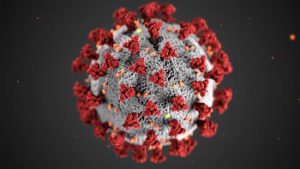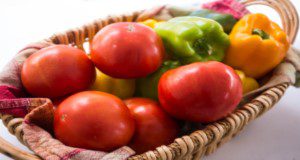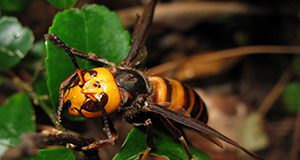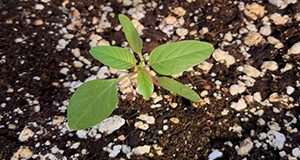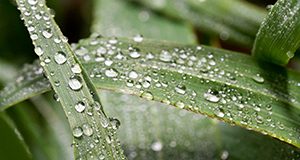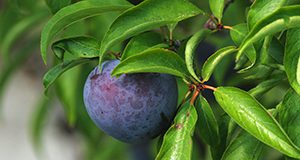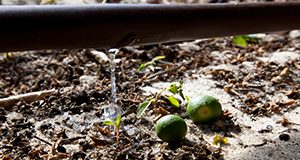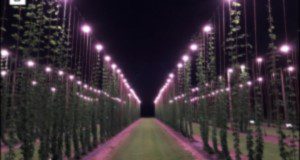This is the Mandarin Chinese translation of FSHN20-31/FS373, COVID-19 Preventative Measures: Do-It-Yourself Cloth Face Coverings. It provides guidance for making and caring for facemasks. Written by Natalie Seymour, Mary Yavelak, Candice Christian, and Ben Chapman, and published by the UF/IFAS Food Science and Human Nutrition Department.
https://edis.ifas.ufl.edu/fs390
Is Coronavirus a Concern on Fresh Produce? (Mandarin Chinese)
This is the Mandarin Chinese translation of FSHN20-22/FS350, Is Coronavirus a Concern on Fresh Produce? It provides guidance relevant to COVID-19 regarding handling and consumption of fresh produce. Written by Natalie Seymour, Mary Yavelak, Candice Christian, and Ben Chapman, and published by the UF/IFAS Food Science and Human Nutrition Department.
https://edis.ifas.ufl.edu/fs389
COVID-19 and Food Safety FAQ: Is Coronavirus a Concern with Takeout? (Mandarin Chinese)
This is the Mandarin Chinese translation of FSHN20-22/FS349, COVID-19 and Food Safety FAQ: Is Coronavirus a Concern with Takeout? It provides answers to frequently asked questions regarding COVID-19 and takeout food. Written by Natalie Seymour, Mary Yavelak, Candice Christian, and Ben Chapman, and published by the UF/IFAS Food Science and Human Nutrition Department.
https://edis.ifas.ufl.edu/fs388
COVID-19 and Food Safety FAQ: Is Coronavirus a Food Safety Issue? (Mandarin Chinese)
This is the Mandarin Chinese translation of FSHN20-18/FS341, COVID-19 and Food Safety FAQ: Is Coronavirus a Food Safety Issue? It provides guidance related to COVID-19 regarding food production, handling, and packaging. Written by Natalie Seymour, Mary Yavelak, Candice Christian, and Ben Chapman, and published by the UF/IFAS Food Science and Human Nutrition Department.
https://edis.ifas.ufl.edu/fs387
COVID-19 Preventative Measures: What to Do If You Are Sick (Mandarin Chinese)
This is the Mandarin Chinese translation of FSHN20-17/FS340, COVID-19 Preventative Measures: What to Do If You Are Sick. It provides guidance for seeking medical attention, staying away from others, and avoiding infecting others. Written by Natalie Seymour, Mary Yavelak, Candice Christian, and Ben Chapman, and published by the UF/IFAS Food Science and Human Nutrition Department.
https://edis.ifas.ufl.edu/fs386
Facts about Wildlife Diseases: Bats and Coronaviruses
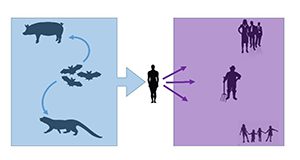
Bats benefit both natural ecosystems and people. Viruses that live in bats can harm people, but transmission of these pathogens from bats to humans can occur only when humans come too close to bats. Recently, misguided attempts to preserve human health have led to persecution of bats. In fact, however, what will keep people healthy is to protect bats and their habitat. This 4-page fact sheet written by Holly K. Ober and Samantha M. Wisely and published by the UF/IFAS Department of Wildlife Ecology and Conservation explains how protecting bat roosts can reduce the likelihood of future zoonotic disease pandemics while also increasing the natural pest reduction services bats provide as they consume insects that cause damage to agronomic crops as well as the mosquitoes that transmit diseases like Zika, dengue, malaria, and chikungunya. Finally, protecting bat roosts keeps bats safely distanced from people, whereas destroying their homes risks the health of both people and bats because it forces bats into closer proximity to people.
https://edis.ifas.ufl.edu/uw473
Finding and Using a Co-Packer
A contract packager, commonly called a co-packer, is a manufacturer that will produce, package, and/or label a product for clients. This new 7-page factsheet provides a brief overview on the definition of co-packers, advantages and disadvantages of using a co-packer, and the list of things you need to consider when you hire and work with a co-packer. It also includes a noncomprehensive list of co-packers in Florida and Georgia. This factsheet is one in the Food Entrepreneurship in Florida series, which serves as a useful guide to help run a successful food-related business. Written by Alison O’Donoughue, Wendi Jennings, and Soohyoun Ahn, and published by the UF/IFAS Food Science and Human Nutrition Department.
https://edis.ifas.ufl.edu/fs380
Jere COVID-19: Pwodwi jaden ak izin anbalaj yo
Pandan ke pa gen prèv ki asosye viris COVID-19 la a yon pwoblèm sekirite alimantè, li se yon pwoblèm sante pou travayè yo paske li pwopaje l pa kontak moun ak moun oswa lè w manyen yon sifas ki kontamine. Manje pa parèt tankou yon kòz ki favorize transmisyon COVID-19 la, men menm pratik yo itilize pou evite maladi ou ka pran nan manje, menm pratik sa yo ta dwe itilize pou diminye chans kontaminasyon COVID-19 la nan nan pwodwi alimentè ki fre yo epi risk pou COVID-19 ta simaye l pami travayè agrikòl yo ak sa kap travay nan izin anbalaj yo.
This new 2-page publication of the UF/IFAS Food Science and Human Nutrition Department is the Haitian Creole translation of FSHN20-25, Handling COVID-19: Produce Farms and Packinghouses. Written by Laurel Dunn (UGA) and translated by Emmanuel Duvalsaint.
https://edis.ifas.ufl.edu/fs385
Etalaj fwi, legim ak lòt pwodwi agrikòl nan peryòd COVID-19: kisa machann yo ka fè pou pwoteje tèt yo ok kliyan yo
Agrikiltè ak kliyan yo pa dwe ale kote yo etale fwi, legim ak lòt pwodwi agrikòl pou vann si yo gen sentòm COVID-19 la, oswa si yo ta antre an kontak ak yon moun ki malad. Nenpòt moun ki ta gen sentòm yo ap kite espas sa a.
This new 2-page publication of the UF/IFAS Food Science and Human Nutrition Department is the Haitian Creole translation of FSHN20-28, COVID-19 and Farm Stands: Steps for Farm Stand Operators. Written by Natalie Seymour, Mary Yavelak, Candice Christian, and Ben Chapman (all of NCSU) and translated by Emmanuel Duvalsaint.
https://edis.ifas.ufl.edu/fs384
Antibiotics in Crop Production
This new 5-page article presents an overview of the use of antibiotics in agriculture. Several of the most severe bacterial diseases of tree fruit and other crops are discussed and their integrated management, which includes the use of antibiotics, is described. Antibiotic use for plant disease protection is compared with the use of antibiotics in livestock production, and their future and limitations in plant production are discussed. Written by Leigh Archer, Ute Albrecht, and Pamela Roberts, and published by the UF/IFAS Horticultural Sciences Department.
https://edis.ifas.ufl.edu/hs1366
Sekirite alimante ak COVID-19 : Kesyon yo poze souvan : Eske kowona viris se yon pwoblem nan pwodiksyon fwi ak legim
Nan moman sa a, CDC, FDA ak USDA pa rapòte okenn ka maladi ki ta sigjere kowona viris la ka transmèt sòti nan manje oswa nan anbalaj pwodwi alimantè. Rechèch ki fèt sou viris ki menm jan an tankou SARS ak grip montre risk transmisyon viris la pou l ta sòti nan yon manje fèb anpil. Pandan ke pa gen anpil enfòmasyon sou ki kantite tan viris la ka fè sou yon sifas, risk pou transmisyon an ta sòti nan yon manje fèb epi li pa ta dwe enkyete nou.
This new 2-page publication of the UF/IFAS Food Science and Human Nutrition Department is the Haitian Creole translation of FSHN20-23, COVID-19 and Food Safety FAQ: Is Coronavirus an Issue in Produce Production?. Written by Natalie Seymour, Mary Yavelak, Candice Christian, and Ben Chapman (all of NCSU) and translated by Emmanuel Duvalsaint.
https://edis.ifas.ufl.edu/fs383
COVID-19 mezi prevantif: mas an twal pou anplwaye ki nan sekte alimante
Daprè CDC, yon metòd efikas pou kwape pwopagasyon maladi enfektye sa a se lè w kouvri visaj ou ak yon twal oswa w mete yon mas an twal. Yo itilize mas an twal yo pou kouvri bouch ak nen yon moun ki enfekte oswa ki ta ka enfekte si l pran viris la lè yon moun ap touse, estènen oswa nan yon konvèsasyon nòmal. Mas an twal yo bay bon jan pwoteksyon si yo 1) bon kalite 2) mete yo byen 3) sèvi ak yo byen. Lè w mete yon mas an twal, li ka diminye ris men li pa bay yon pwoteksyon total kapital. Nou dwe swiv lòt metòd pou diminye ris yo tankou: pa rete pre yonn ak lòt, lave men nou, itilize sanitzè/dezenfektan pou men epi evite manyen je w, nen w ak bouch ou.
This new 2-page publication of the UF/IFAS Food Science and Human Nutrition Department is the Haitian Creole translation of FSHN20-33, COVID-19 Preventative Measures: Cloth Face Coverings for Food Employees. Written by Natalie Seymour, Mary Yavelak, Candice Christian, and Ben Chapman (all of NCSU) and translated by Emmanuel Duvalsaint.
https://edis.ifas.ufl.edu/fs382
Jere COVID-19 : Pi bon Pratik pou Agribiznis
COVID-19 simaye l sitou pa kontak dirèk moun ak moun, oswa si pandan yon moun ap touse oubyen pale postiyon krache a ki deja gen viris la kontamine yon sifas epi yon moun ki ansante manyen kote sa a. Pandan ke pifò magazen manje ak ekipman kontinye fonksyone pandan maladi a ap simaye ak lòt ijans, kèk mezi prevantif ka pran pou pwoteje sante anplwaye yo ak kliyan yo.
This new 2-page publication of the UF/IFAS Food Science and Human Nutrition Department is the Haitian Creole translation of FSHN20-27, Handling COVID-19: Best Practices for Agribusiness. Written by Tom Maddox and Laurel Dunn (both of the University of Georgia) and translated by Emmanuel Duvalsaint.
https://edis.ifas.ufl.edu/fs381
Yellow-Legged Hornet (suggested common name), Vespa velutina (Lepeletier 1836) (Insecta: Hymenoptera: Vespidae)
The yellow-legged hornet, Vespa velutina (Lepeletier), is a pest of concern outside of its native range. Vespa velutina is native to Southeast Asia and has invaded several regions in Europe, first appearing in France in 2004. As a generalist predator, they are a pest of honey bees and a major concern to many beekeepers. Vespa velutina has not been intercepted in North America, but it is believed to have high invasion potential. This 5-page fact sheet written by Krystal Ashman, Oliver Keller, and Cameron Jack and published by the UF/IFAS Entomology and Nematology Department describes the hornet and explains its live cycle, biology, and some of its predatory strategies.
https://edis.ifas.ufl.edu/in1282
Asian Giant Hornet, Vespa mandarinia Smith (1852) (Insecta: Hymenoptera: Vespidae)
Vespa mandarinia Smith, commonly called the Asian giant hornet, is the largest hornet in the world. Its size and distinctive markings make it easily distinguishable from other Asian hornet species. Not only is the wasp occasionally life-threatening to humans, it can decimate a number of insect colonies, most notably wild and farmed honey bees. Vespa mandarinia is native to Japan and occurs in several countries in Asia. The first Vespa madarinia hornet detected in the United States was in Washington State in 2019. This 5-page fact sheet written by Caitlin Gill, Cameron Jack, and Andrea Lucky and published by the UF/IFAS Entomology and Nematology Department describes the hornet, its biology, its predatory strategies, and its medical significance. The fact sheet also provides some strategies for management of this dangerous and destructive hornet.
https://edis.ifas.ufl.edu/in1281
Amaranthus palmeri—Palmer Amaranth
Palmer amaranth has become one of the most troublesome weeds in the southeastern US due to its vigorous growth rate, high seed production, and development of resistance to herbicides from multiple modes of action. This 4-page publication illustrates characteristics of this weed to assist in accurate identification, proper management, and development of effective control strategies. Written by Sergio Morichetti, Jason Ferrell, and Pratap Devkota, and published by the UF/IFAS Agronomy Department, revised April 2020.
https://edis.ifas.ufl.edu/ag346
How to Avoid Common Problems with Leaf Wetness Sensor Installation and Maintenance
Leaf wetness duration is an essential input in disease prediction models and decision support systems in Florida and elsewhere. Incorrect installation or lack of regular maintenance of leaf wetness sensors may lead to errors in plant disease risk monitoring and negative impacts on yield. This 7-page publication provides detailed guidelines for the proper installation and maintenance of leaf wetness sensors and describes the most common problems found in field installations as well as potential solutions. Written by T. B. Onofre, C. W. Fraisse, N. A. Peres, and J. McNair, and published by the UF/IFAS Department of Agricultural and Biological Engineering, February 2020.
https://edis.ifas.ufl.edu/ae538
Cultivo de ciruelas en Florida
Las ciruelas podrían ser un cultivo potencial para los productores y propietarios de viviendas en Florida y otras áreas de invierno templado en toda la costa del Golfo, pero muchas variedades de ciruelas de la costa oeste no funcionarán de manera consistente en Florida para producir fruta. Sin embargo, el programa de mejoramiento de fruta de hueso de la Universidad de Florida ha desarrollado cultivares que mejoran el potencial para el cultivo de ciruelas en Florida y otras áreas de invierno templado que tienen alta presión de enfermedades. Estos cultivares se recomiendan para probar en Florida. Los nombres de todos los cultivares de ciruela de la Universidad de Florida comienzan con el prefijo 'Gulf'. Estos cultivares son ciruelas de tipo japonés (Prunus salicina Lindl.) y tienen resistencia al escaldado de hojas de ciruela (Xylella fastidiosa) y a la bacteriosis o cribado (Xanthomonas campestris). El tamaño del fruto es satisfactorio (aproximadamente 1½ a 2 pulgadas de diámetro) con buena calidad del fruto. Maduran a principios o finales de mayo, aproximadamente dos semanas antes de que las ciruelas de otras áreas lleguen al Mercado.
This new 14-page fact sheet is the Spanish translation of HS895/HS250, Growing Plums in Florida, written by A. Sarkhosh, M. Olmstead, E. P. Miller, P. C. Andersen, and J. G. Williamson, translated by Tatiana Sanchez, and published by the UF/IFAS Horticultural Sciences Department.
https://edis.ifas.ufl.edu/hs1364
Basic Tips for Designing Efficient Irrigation Systems
As freshwater resources become increasingly scarce and droughts become more frequent, there is a need for efficient use of water resources. Designing efficient irrigation systems and equipment will not only save money but also conserve water. This 10-page fact sheet discusses factors to consider when designing irrigation systems. Written by Haimanote K. Bayabil, Kati W. Migliaccio, Michael Dukes, and Laura Vasquez, and published by the UF/IFAS Department of Agricultural and Biological Engineering, February 2020.
https://edis.ifas.ufl.edu/ae539
Using Supplemental Lighting to Control Flowering of Hops in Florida
Hops (Humulus lupulus L.) are an emerging crop in Florida. Florida’s craft beer industry has experienced significant growth over the last 10 years, with 285 breweries producing 42.6 million gallons of beer and generating an economic impact of $3.6 billion in 2018. To respond to their strong demand for locally grown hops, an interdisciplinary hops research team is currently studying optimum crop management practices at the UF/IFAS Gulf Coast Research and Education Center (UF/IFAS GCREC). In Florida, the major yield-limiting factor is premature flowering induced by inadequate day length. This new 4-page article, written by Shinsuke Agehara and published by the UF/IFAS Horticultural Sciences Department, provides guidelines for supplemental lighting to control flowering of hops in Florida.
https://edis.ifas.ufl.edu/hs1365
